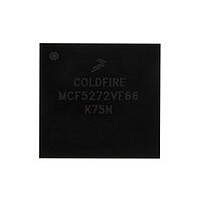MCF5272VF66 Freescale, MCF5272VF66 Datasheet - Page 469

MCF5272VF66
Manufacturer Part Number
MCF5272VF66
Description
Manufacturer
Freescale
Datasheet
1.MCF5272VF66.pdf
(544 pages)
Specifications of MCF5272VF66
Family Name
MCF5xxx
Device Core
ColdFire
Device Core Size
32b
Frequency (max)
66MHz
Instruction Set Architecture
RISC
Supply Voltage 1 (typ)
3.3V
Operating Temp Range
0C to 70C
Operating Temperature Classification
Commercial
Mounting
Surface Mount
Pin Count
196
Package Type
MA-BGA
Lead Free Status / RoHS Status
Not Compliant
Available stocks
Company
Part Number
Manufacturer
Quantity
Price
Company:
Part Number:
MCF5272VF66
Manufacturer:
HYNIX
Quantity:
19
Company:
Part Number:
MCF5272VF66
Manufacturer:
FREESCAL
Quantity:
885
Company:
Part Number:
MCF5272VF66
Manufacturer:
Freescale Semiconductor
Quantity:
10 000
Part Number:
MCF5272VF66
Manufacturer:
FREESCALE
Quantity:
20 000
Company:
Part Number:
MCF5272VF66J
Manufacturer:
Freescale
Quantity:
256
Company:
Part Number:
MCF5272VF66J
Manufacturer:
Freescale Semiconductor
Quantity:
10 000
Company:
Part Number:
MCF5272VF66R2
Manufacturer:
Freescale Semiconductor
Quantity:
10 000
Company:
Part Number:
MCF5272VF66R2J
Manufacturer:
Freescale Semiconductor
Quantity:
10 000
- Current page: 469 of 544
- Download datasheet (7Mb)
20.11 Bus Arbitration
The MCF5272 does not allow external bus masters. There are three on-chip bus masters. These are the
ColdFire core, the Fast Ethernet Controller, and the memory-to-memory DMA Controller.
20.12 Reset Operation
The MCF5272 supports four types of reset, two of which are external hardware resets (master reset and
normal reset), a soft reset, which is generated by setting SCR[SOFTRST], and the software watchdog
reset.
There are two reset input pins, RSTI and DRESETEN. When DRESETEN is asserted, any of the reset
sources reset the SDRAM controller. When DRESETEN is negated, the SDRAM controller is not reset.
This is useful during software debugging since it is preferable to retain SDRAM data in the case of
catastrophic system failure. In a production system, if may be preferable to tie DRESETEN low.
Master reset resets the entire MCF5272 including the SDRAM controller. Master reset occurs when both
RSTI and DRESETEN are asserted simultaneously. This is the reset that should be applied to the
MCF5272 device at power up.
Normal reset resets all of the MCF5272 with the exception of the SDRAM controller. Normal reset occurs
when RSTI is asserted and DRESETEN is negated. Normal reset allows DRAM refresh cycles to continue
at the programmed rate and with the programmed waveform timing while the remainder of the system is
being reset, maintaining the data stored in DRAM.
SCR[SOFTRST] resets all on-chip peripherals and devices connected to RSTO. It resets the SDRAM
controller only when DRESETEN is asserted.
The software watchdog reset acts as an internally generated normal reset when DRESETEN is negated. It
resets the SDRAM controller only when DRESETEN is asserted.
Freescale Semiconductor
TEA normally should be asserted for no more than three CLKIN periods.
The minimum is two clock periods.
TEA is internally synchronized on the rising edge of CLKIN. Depending on
when this synchronization takes place, the Cx cycle may not occur.
Master reset must be asserted for all power-on resets. This is done by driving
RSTI and DRESETEN low simultaneously. Failure to assert master reset
during power-on sequences results in unpredictable DRAM controller
behavior.
MCF5272 ColdFire
®
Integrated Microprocessor User’s Manual, Rev. 3
NOTE
NOTE
NOTE
Bus Operation
20-21
Related parts for MCF5272VF66
Image
Part Number
Description
Manufacturer
Datasheet
Request
R
Part Number:
Description:
Mcf5272 Coldfire Integrated Microprocessor User
Manufacturer:
Freescale Semiconductor, Inc
Datasheet:

Part Number:
Description:
MCF5272 Interrupt Service Routine for the Physical Layer Interface Controller
Manufacturer:
Freescale Semiconductor / Motorola
Datasheet:

Part Number:
Description:
TOWER ELEVATOR BOARDS HARDWARE
Manufacturer:
Freescale Semiconductor
Datasheet:

Part Number:
Description:
TOWER SERIAL I/O HARDWARE
Manufacturer:
Freescale Semiconductor
Datasheet:

Part Number:
Description:
LCD MODULE FOR TWR SYSTEM
Manufacturer:
Freescale Semiconductor
Datasheet:

Part Number:
Description:
DAUGHTER LCD WVGA I.MX51
Manufacturer:
Freescale Semiconductor
Datasheet:

Part Number:
Description:
TOWER SYSTEM BOARD MPC5125
Manufacturer:
Freescale Semiconductor
Datasheet:

Part Number:
Description:
KIT EVALUATION I.MX51
Manufacturer:
Freescale Semiconductor
Datasheet:

Part Number:
Description:
KIT DEVELOPMENT WINCE IMX25
Manufacturer:
Freescale Semiconductor
Datasheet:

Part Number:
Description:
TOWER SYSTEM KIT MPC5125
Manufacturer:
Freescale Semiconductor
Datasheet:

Part Number:
Description:
TOWER SYSTEM BOARD K40X256
Manufacturer:
Freescale Semiconductor
Datasheet:

Part Number:
Description:
TOWER SYSTEM KIT K40X256
Manufacturer:
Freescale Semiconductor
Datasheet:

Part Number:
Description:
Microcontrollers (MCU) MX28 PLATFORM DEV KIT
Manufacturer:
Freescale Semiconductor
Datasheet:

Part Number:
Description:
MCU, MPU & DSP Development Tools IAR KickStart Kit for Kinetis K60
Manufacturer:
Freescale Semiconductor
Datasheet:

Part Number:
Description:
24BIT HDMI MX535/08
Manufacturer:
Freescale Semiconductor
Datasheet:











